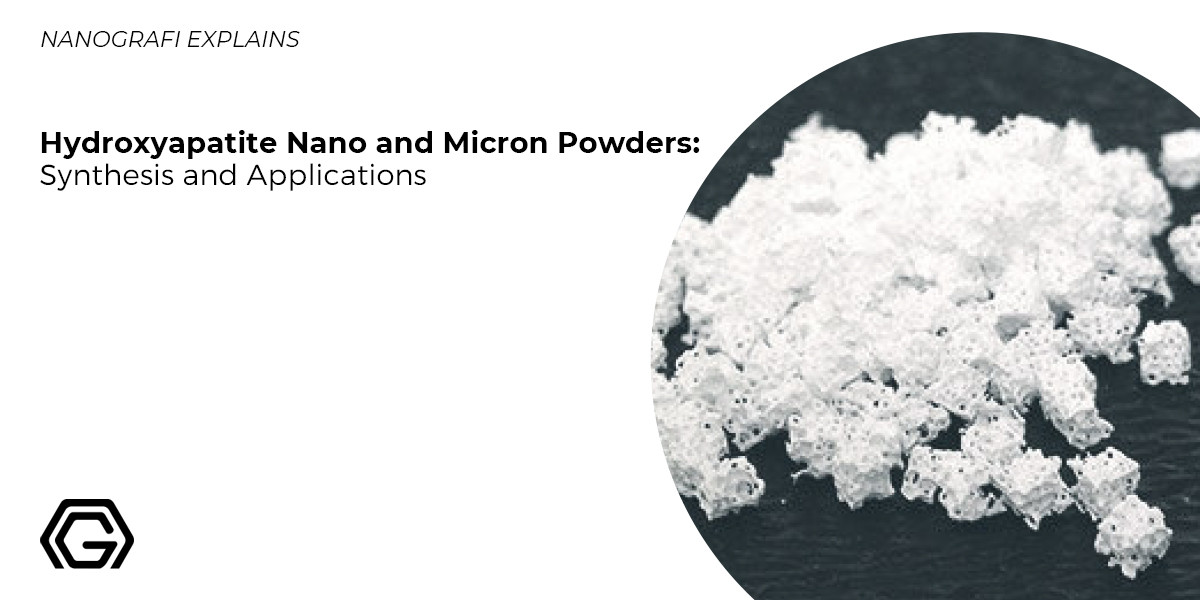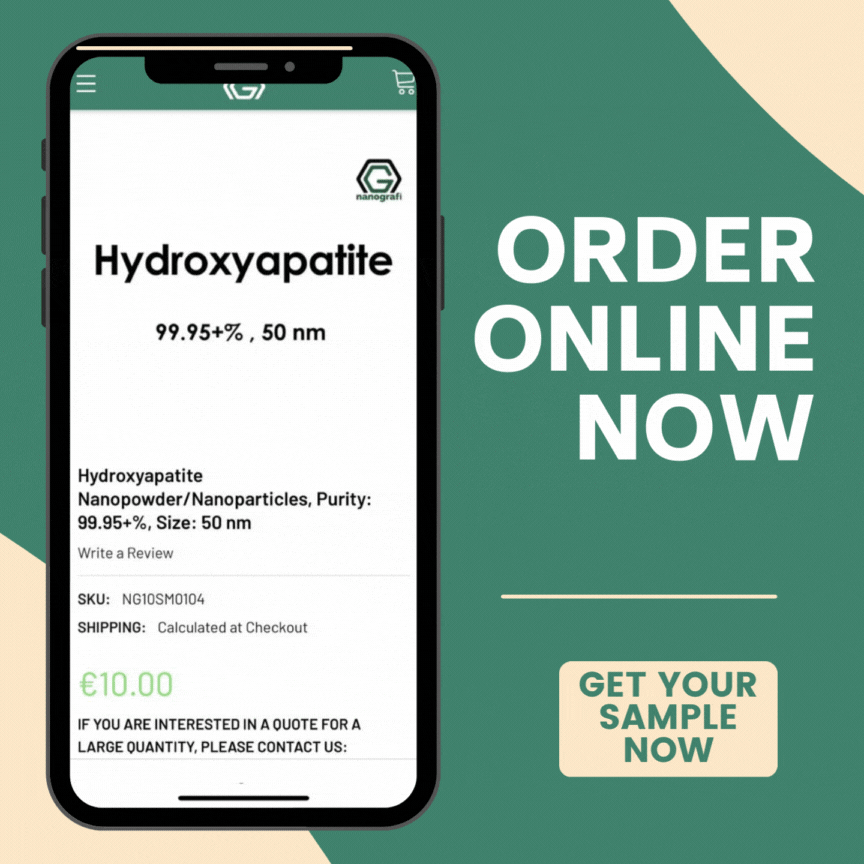Hydroxyapatite Nano and Micron Powders: Synthesis and Applications - Nanografi
Unlocking unique capabilities in biomedical, dental, and materials science, hydroxyapatite powders promise significant advancements in tissue engineering, drug delivery, and bone graft substitutes due to their exceptional biocompatibility and mechanical properties.
Hydroxyapatite powders are valuable materials with unique properties. When processed into nano-sized particles, hydroxyapatite powders have high surface area, promoting better integration with tissues and enhancing cell interactions. These nano-sized hydroxyapatite powders find applications in tissue engineering and drug delivery. When processed into micron-sized particles, hydroxyapatite powders have excellent mechanical properties and are used in orthopedics and dentistry for bone graft substitutes and coatings. Hydroxyapatite powders, whether in nano or micron size, hold promise for advancing various fields and improving human health. At Nanografi, we aim to achieve groundbreaking advancements in biomedical and materials science with our hydroxyapatite powders. Be part of this transformation and contribute to strides towards a healthier, more efficient future.
Introduction
Hydroxyapatite is a calcium phosphate compound, its formula is Ca10 (PO4)6(OH)2. It is a part of the raw material, called phosphoric rock. The term hydroxy refers to the anion OH‑. If instead of that anion is replaced with fluoride, the mineral would be called Fluoroapatite Ca10 (PO4)6(F)2. Hydroxyapatite is the main inorganic component of the bones and dental enamel. Hydroxyapatite is a mineral used in various applications, particularly in the biomedical and dental fields. It is commonly used in the production of dental implants, bone filling materials, and teeth whitening products.
Hydroxyapatite exists in two main forms: nanoHydroxyapatite powder and micron Hydroxyapatite powder. The primary difference between the two forms is their particle size. NanoHydroxyapatite powder has particles below 200 nm in size, while Hydroxyapatite micron powder ranges from 45 to 90 microns. NanoHydroxyapatite powder has a surface area of around 9.4 m2/g, whereas micron Hydroxyapatite powder has a higher surface area of 120 m2/g.
When discussing hydroxyapatite powder, the specific topic is the powder derived from hydroxyapatite. It can be used in various applications in this form. On the other hand, the term "micron powder" refers to the particle size of a powder, typically denoted in micrometers (µm). Micron powder is used to describe powders with fine particles within a specific size range. For instance, a powder with particle sizes ranging from 1 to 10 microns can be referred to as "micron powder."
Hydroxyapatite powder can be referred to as micron powder, but the term "micron powder" is used to indicate the particle size range of a powder, while hydroxyapatite powder specifically refers to the hydroxyapatite itself.
Hydroxyapatite Powder
Properties of Hydroxyapatite Powder
The most prominent property of hydroxyapatite powder is the level of its stability at the time of comparison with the other calcium phosphates. However, it is believed to be that calcium phosphate compound which is the most stable under the influence of physical conditions such as the composition of body fluids, pH and temperature. Following are the exceptional chemical properties of hydroxyapatite powder:
Biocompatibility
One of the excellent property of hydroxyapatite powder is biocompatibility. It enhances the biocompatibility of all the products it is used in.
Bioactivity
Another good property of hydroxyapatite powder is bioactivity. All the products or minerals which have hydroxyapatite powder extraction in them speeds up the bioactivity of those products or minerals.
Osteoconductivity
Osteoconductivity too is one of the greatest properties of hydroxyapatite powder. As hydroxyapatite powder can either be transparent or opaque, so osteoconductivity is exceptionally enhanced in it.
Non-Toxicity and Non-Inflammatory Nature
Hydroxyapatite powder possesses the non-toxic and non-inflammatory nature that is why it can be used for various purposes as it has no harmful, toxic or inflammatory effects on any of the things it is mixed with.
Following are the physical properties:
1) Like all the other ceramics, hydroxyapatite is also very brittle.
2) The natural color of hydroxyapatite powder is white or off-white. The color may vary depending on the presence of other elements and the level of purity, but it is typically white.
3) It can be transparent or opaque.
4) It gets degraded in the solution of 2.0 pH.
Uses of Hydroxyapatite Powder
Hydroxyapatite powder is used in various fields for various purposes which are mentioned below as it is one of the most preferred minerals in the industry because of its remarkable benefits.
Uses of Hydroxyapatite Powder in Cosmetics
Hydroxyapatite (HAp) powder is an ingredient found in products such as Johnson's Aloe and Vitamin E powder, contributing to the moisturization and softening of babies' skin. It is also present in makeup kits, initially intended to provide moisture and softness to the skin. However, HA powder has significant applications beyond skincare and hair care. It is widely utilized in dental health for its role in remineralizing tooth enamel and promoting healthier teeth and gums. Additionally, HA powder finds application in various other fields, including cosmetics, hair care, pharmaceuticals, and even food supplements. The versatility of HAp powder continues to expand through ongoing research and development efforts.
Uses of Hydroxyapatite Powder in Dental
In particular, hydroxyapatite powder is widely used in a range of products for teeth:
Teeth Whitening Products: Hydroxyapatite powder is utilized in toothpaste, mouthwashes, and whitening strips to help remove surface stains and restore the natural whiteness of teeth.
Products: Hydroxyapatite powder is added to toothpaste formulations to aid in remineralizing tooth enamel and preventing tooth decay.
Enamel Repair: Hydroxyapatite powder can be used in cosmetic dental procedures to repair and restore damaged tooth enamel, improving the appearance and strength of teeth.
Bodily Implantations: It is used in hip replacements, dental implants, and bone conduction implants. Its fine coating enhances the biocompatibility of these implants.
Dental Restorations: Hydroxyapatite powder improves the compatibility of restorative materials like fillings and composites with natural tooth structures. To learn more about the latest trends in dental applications of nanomaterials, you can read our blog.
Dental Implants: Hydroxyapatite powder is utilized in dental implants to enhance osseointegration and promote bone growth for improved stability and long-term success of the implant.
Periodontal Treatments: It aids in procedures such as bone grafting and guided tissue regeneration.
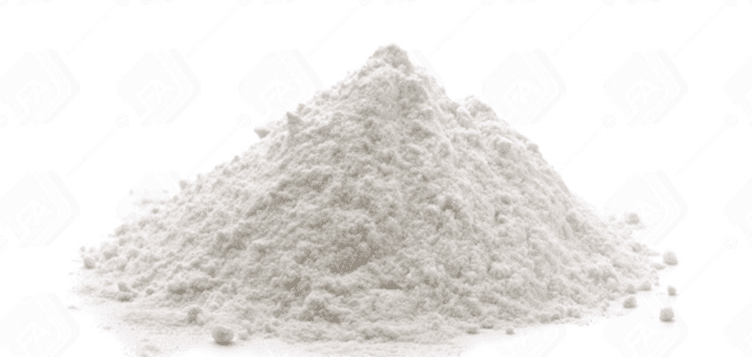
Figure 1. Appearance of Hydroxyapatite Powder.
Uses of Hydroxyapatite Powder in Supplements
Hydroxyapatite powder is also present in another form that is the microcrystalline form, and this form of hydroxyapatite is very much known as a supplement that has a very high rate of absorbing as compared to calcium and is retailed as a bone-building mineral in the powdered form. It is mainly the supplement for calcium and has been derived from the bovine bone. Along with that, there are certain, and countless companies proclaim this that the HA powder used in the supplements is corrupted by the usage of heavy metals as its effective causes have not proved to be well in the field.
Uses of Hydroxyapatite Powder in Archaeology
Hydroxyapatite powder is also being used in the field of archeology for the reconstruction of the migrants, diets and climatic changes of the human and animal remains. Bone and teeth in their mineral forms play the role of reservoirs of the trace elements, which also include carbon, oxygen and strontium. The hydroxyapatite powder is constructively used for the indication of the diet as in which state it is present, the habits which a human or animal adopt according to the geographical regions or origins and abruptly for that reconsolidation of the previous temperatures and the shifts of the climatic changes.
Uses of Hydroxyapatite Powder in Chromatography
Hydroxyapatite powder is also being used in the process of chromatography. It is one of the very complex processes and is often also known as mixed mode. It basically represents the attraction and reaction of positive and negative ions which are then converted to ions. For the purpose of purification, HAp chromatography’s efficacy cannot be predicted on the basis of physical and chemical properties it holds. For the purpose of elution, the buffers having a high quantity of phosphate or the neutral salt are most preferably used.

Figure 2: Uses of Hydroxyapatite Powder.
Uses of Hydroxyapatite Powder in Defluoridation
Hydroxyapatite powder works as an excellent adsorptive mineral to complete the defluoridation of normal drinking water. This is due to the reason that HA powder can form fluorapatite in a process following three steps only. The mineral HAp powder helps in the removal of fluoride ions from the water, and it then replaces those fluoride ions with the hydroxyl ions which actually makes fluorapatite which is incredibly useful in the purification of the contaminated water.
Uses of Hydroxyapatite Powder in Mammals/Humans/Primates
In mammals, humans or primates the hydroxyapatite is present at two different places. One is bone, and the other is teeth.
In bone, the matrix of collagen is sixty-five to seventy percent of the mass which is basically hydroxyapatite. In teeth, the matrix of dentin and enamel are seventy to eighty percent of the mass which is basically hydroxyapatite
All the studies show that the harmful effects associated with the usage of HAp powder in all the different fields are very less and are almost unlikely to be recorded. Along with that, the studies also show briefly that the usage of HAp powder that is the calcium phosphate nanoparticles are considered very safe for humans. Besides being safe, these products bring ease and efficacy too in the lives of humans so the usage of this mineral should be continued and various other ways should be explored in which humans can make it more beneficial for them.
Hydroxyapatite Micron Powder
Properties of Hydroxyapatite Micron Powder
Hydroxyapatite (HAp), often denoted as Ca10(PO4)6(OH)2, is a naturally occurring mineral form of calcium apatite, and it is the main inorganic component of bone and teeth. This segment introduces the relevance of hydroxyapatite in various fields, especially when in micron powder form.
Physical Properties
Hydroxyapatite micron powder is characterized by its white color and crystalline structure. Its high surface area due to the micron-size allows for increased interaction in various applications. This segment provides a detailed exploration of the physical properties of hydroxyapatite micron powder.
Chemical Properties
In this section, we discuss the chemical properties of hydroxyapatite micron powder. This includes its stability, reactivity, and how it interacts with other substances in the environment.
Biocompatibility
One of the key properties of hydroxyapatite micron powder is its high biocompatibility, meaning it interacts favorably with biological systems, such as human tissues. This section discusses the biocompatibility of hydroxyapatite micron powder and its relevance in biomedical applications.
Synthesis Methods
Hydroxyapatite micron powder can be synthesized using various methods. This section explores the most common methods, including wet chemical deposition and sol-gel techniques.
Uses of Hydroxyapatite Micron Powder
Coating Applications
- Biomedical Coatings:
Orthopedic Implants: Hydroxyapatite micron powder can be used as a coating material for orthopedic implants, enhancing their biocompatibility and promoting successful integration with the surrounding bone tissue.
If the topic catches your attention, you can read our blog which examines on IR Coating Technology and its various applications.
Dental Implants: Hydroxyapatite micron powder coatings are applied to dental implants to improve their stability and biocompatibility, ensuring a successful implantation process.
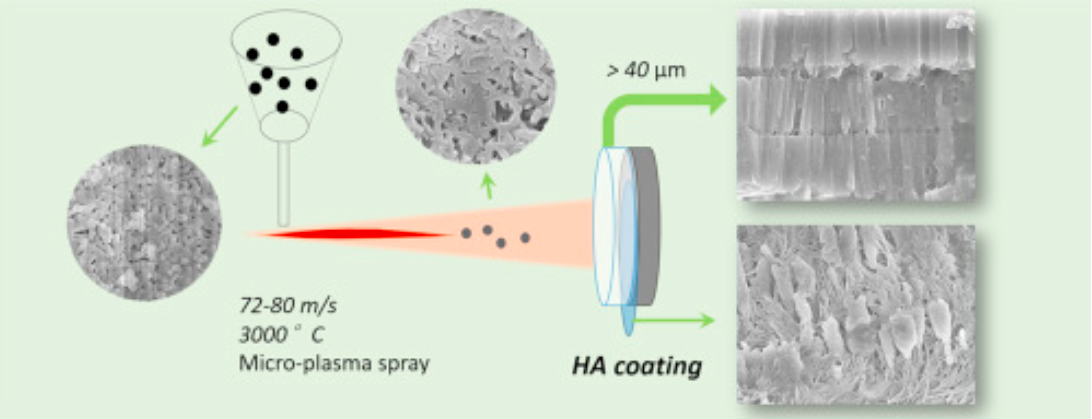
Figure 3. Hydroxyapatite Coating.
- Protective Coatings
Corrosion Protection: Hydroxyapatite micron powder coatings can provide corrosion resistance to metal surfaces, extending their lifespan and protecting them from environmental factors.
Heat and Wear Resistance: Coating surfaces with hydroxyapatite micron powder can enhance their resistance to heat and wear, making them suitable for high-temperature applications and reducing friction.
- Anti-Fouling Coatings:
Underwater Structures: Hydroxyapatite micron powder is utilized in anti-fouling coatings for underwater structures like ship hulls, preventing the attachment and growth of marine organisms such as algae, barnacles, and bacteria.
- Optical Coatings:
Anti-Reflective Coatings: Hydroxyapatite micron powder coatings can be applied to optical surfaces to reduce surface reflections and improve light transmission, enhancing the performance of lenses, glasses, and optical instruments.
Biocompatible Optical Coatings: Hydroxyapatite coatings are used in biomedical devices and implants as biocompatible coatings for optical components, minimizing adverse reactions with biological tissues.
- Bioactive Coatings:
Bone Tissue Engineering: Hydroxyapatite micron powder coatings are utilized in bioactive coatings for scaffolds and implants in bone tissue engineering, promoting bone regeneration and integration.
Biomedical Applications
- Bone Tissue Engineering: Hydroxyapatite micron powder is widely used in the field of bone tissue engineering. It provides a scaffold for cell attachment and growth, aiding in the regeneration of damaged or lost bone tissue.
- Drug Delivery Systems: The high surface area and biocompatibility of hydroxyapatite micron powder make it suitable for drug delivery systems. It can be used as a carrier for controlled release of pharmaceutical compounds.
Dental Applications
- Dental Fillings and Restorations: Hydroxyapatite micron powder is utilized in dental restorative materials like fillings and composites. Its bioactivity and compatibility with tooth structures make it an excellent choice for dental restorations.
- Root Canal Treatment: Hydroxyapatite micron powder can be used as a filler material in root canal treatments. It helps in sealing and strengthening the root canal, promoting successful treatment outcomes.
Cosmetics Industry
- Skincare Products: Hydroxyapatite micron powder is utilized in various skincare products such as creams, lotions, and serums. It provides benefits like improved skin hydration, increased collagen production, and enhanced skin elasticity.
- Sunscreens: Hydroxyapatite micron powder is also used in sunscreens as a physical UV filter. It helps to protect the skin from harmful UV radiation by reflecting and scattering the sun's rays.
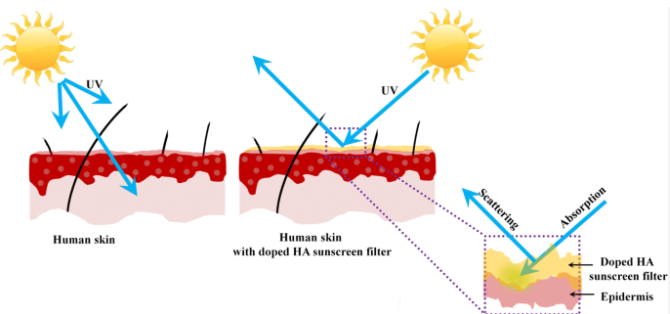
Environmental Applications
- Water Purification: Hydroxyapatite micron powder can be employed in water treatment processes for the removal of heavy metals and fluoride ions. Its adsorption capabilities make it effective in purifying contaminated water sources.
- Soil Remediation: Hydroxyapatite micron powder is used in soil remediation to immobilize and remove toxic heavy metals from polluted soils, thereby restoring soil health.
Research and Development
Hydroxyapatite micron powder serves as a valuable material for scientific research and development in various fields. It is used in studies related to biomaterials, drug delivery systems, bone regeneration, and tissue engineering.
Industrial Applications
Hydroxyapatite micron powder finds applications in diverse industrial sectors, including catalysts, coatings, ceramics, and electronics. Its unique properties, such as high hardness, thermal stability, and biocompatibility, contribute to its suitability in these industrial applications.
Conclusion
Hydroxyapatite nano and micron powders have diverse synthesis methods and applications. Nano-sized powders are promising in biomedical fields like tissue engineering, while micron-siz
ed powders find use in orthopedics, dentistry, coatings, and industry. They are utilized in implants, drug delivery, protective coatings, and more. With their unique properties, hydroxyapatite powders contribute to technological advancements and improve human health. Ongoing research aims to further explore their potential in various applications. Given the versatile potential of hydroxyapatite powders, choosing a reliable and quality-focused source like Nanografi ensures you are optimally positioned to drive groundbreaking research and innovation in diverse scientific fields.
References
Francois, E. L., & Yaszemski, M. J. (2018). Preclinical Bone Repair Models in Regenerative Medicine. Principles of Regenerative Medicine, 761–767. https://doi.org/10.1016/B978-0-12-809880-6.00043-6
George, S., Mehta, D., & Saharan, V. K. (2018). Application of hydroxyapatite and its modified forms as adsorbents for water defluoridation: an insight into process synthesis. Reviews in Chemical Engineering, 36(3), 369–400. https://doi.org/10.1515/REVCE-2017-0101
HYDROXYAPATITE. (n.d.). Retrieved March 26, 2024, from https://www.sangi-eu.com/en/sangis-nano-mhap/hydroxyapatite/
Hydroxyapatite - Wikipedia. (n.d.). Retrieved March 26, 2024, from https://en.wikipedia.org/wiki/Hydroxyapatite
IR Coating Technology and Applications - Nanografi Nano Technology. (n.d.). Retrieved March 26, 2024, from https://nanografi.com/blog/ir-coating-technology-and-applications/
Latest Trends in Dental Applications of Nanomaterials - Nanografi Nano Technology. (n.d.). Retrieved March 26, 2024, from https://nanografi.com/blog/latest-trends-in-dental-applications-of-nanomaterials/
Mehta, D., Saharan, V. K., & George, S. (2023a). Bio-adsorbent hydroxyapatite for drinking water defluoridation: column performance modelling studies. Environmental Science and Pollution Research International. https://doi.org/10.1007/S11356-023-26822-8
Mehta, D., Saharan, V. K., & George, S. (2023b). Bio-adsorbent hydroxyapatite for drinking water defluoridation: column performance modelling studies. Environmental Science and Pollution Research International. https://doi.org/10.1007/S11356-023-26822-8
Pal, A., Hadagalli, K., Bhat, P., Goel, V., & Mandal, S. (2020). Hydroxyapatite—a promising sunscreen filter. Journal of the Australian Ceramic Society, 56(1), 345–351. https://doi.org/10.1007/S41779-019-00354-2/FIGURES/3
Wang, Y., Fan, T., Zhou, Z., & He, D. (2016). Hydroxyapatite coating with strong (002) crystallographic texture deposited by micro-plasma spraying. Materials Letters, 185, 484–487. https://doi.org/10.1016/J.MATLET.2016.09.068
Recent Posts
-
Nanocomposites in Food Packaging
The utilization of nanocomposites in food packaging represents a significant advancement in the fiel …19th Apr 2024 -
What is the Difference Between 7075 and 6061 Aluminum Alloy?
When comparing 7075 aluminum alloy to 6061 aluminum alloy, it's essential to understand their disti …5th Apr 2024 -
Iron-Air Batteries: The Ultimate Guide
Iron-air batteries represent a significant breakthrough in energy storage technology, offering a sus …29th Mar 2024

